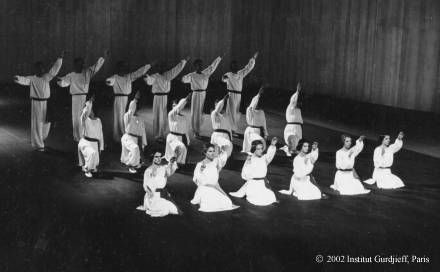

In the summer of 1924 and later, when Mr Gurdjieff was writing Beelzebub’s Tales to His Grandson, the movements were practised regularly, first here in New York (from 1925 on) by the Orage groups, then in England (from 1936 to 1938) by the Ouspensky groups and in Paris by Mme de Salzmann’s groups. Just before the second world war began, Mr Gurdjieff resumed teaching and carried on the work in Paris in spite of the German occupation.
This was an extraordinary period: he created scores of exercises, combinations and sequences, mathematically calculated, designed to help sustain attention and to understand what we now call sensation, to provide shocks and new impressions, and to induce initially certain feelings and more collected states. A great number of these exercises, the “Thirty Nine” and others, he left with us here in New York in the spring of 1949, a few months before he died—and these movements have been studied here ever since.
Some of you worked with Mr Gurdjieff at that time and some have worked since. Everyone, I think, must have found that through the practise of the movements one has direct experiences that lead through the body and feelings to an understanding of many of the work ideas which might, lacking this means, remain simply as theory.
We realise in the movements that we are rarely awake to our own life—inner and outer. We see that we always react in a habitual and conditioned way; we become aware that our three main centres, head, body, feeling, rarely work together or in harmony. We begin to try to move always intentionally—not mechanically—and we discover in ourselves many hitherto unexpected possibilities. We find that one can collect one’s attention; that one can be awake at times and have an overall sensation of oneself; that a quietness of mind, an awareness of body and an interest of feeling can be brought together and that this results in a more complete state of attentiveness in which the life force is felt and one is sensitive to higher influences. Thus, one has a taste of how life can be lived differently.
Because that is so, the movements are sacred for us. With the help of Mme de Salzmann and the teachers she sends us from Paris, we try to keep the movements as pure as when they were first given and to protect them from distortion and superstition.
Tonight our classes are going to share with you the work they are doing in movements at the present time. We wish to share with you memories of Mr Gurdjieff—how, when he would dictate a series of attitudes and rhythms which it seemed impossible to execute, he would respect our individual efforts and help us remember our true aim by often repeating, “Remember inner work! Remember inner work!”
For those who are watching, maybe they could try to decipher in the exercises—especially in the group movements—the language Mr Gurdjieff was using to express in the form of movements—truths—human truths—cosmic truths, the laws he had discovered during a life of search and sacrifice. There again, we remember that sometimes, when we had managed to get through a difficult multiplication series, or other movement based on the enneagram, Mr Gurdjieff, seeing an approximation of the design, the diagram he had intended, would, to our surprise, call out: “Bravo! Bravo!”
| Copyright © 2002 Dushka Howarth This webpage © 2002 Gurdjieff Electronic Publishing Featured: Spring 2002 Issue, Vol. V (1) Revision: April 1, 2002 |
First published in The Gurdjieff Society: Report of the Council to Members (London) April 1995-1996. Jessmin Howarth taught movements in Europe and America from 1924 until her death in 1984. She delivered this talk during a January 13th celebration of Gurdjieff’s birthday in New York City in the early 1980s.